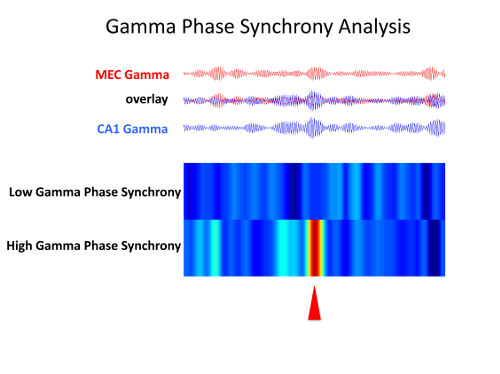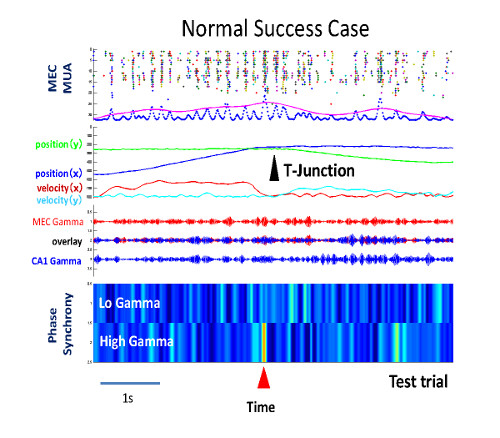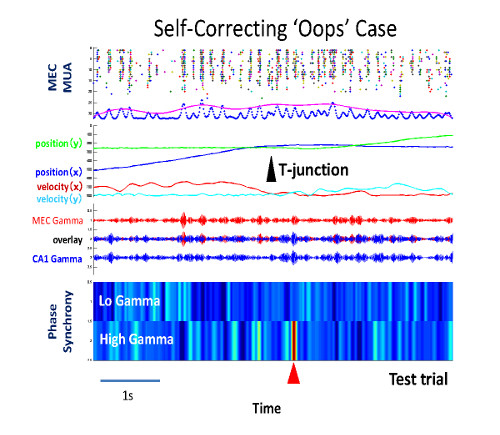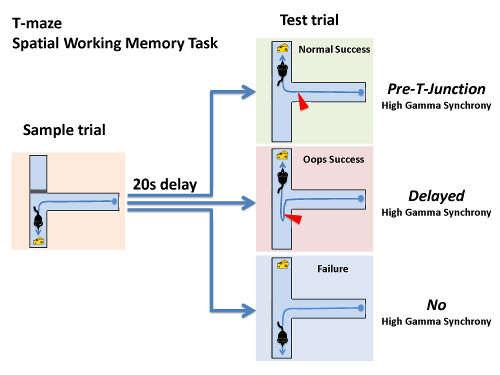Apr. 25, 2014 Press Release Biology
Oops! Researchers find neural signature for mistake correction
Culminating an 8 year search, scientists at the RIKEN-MIT Center for Neural Circuit Genetics captured an elusive brain signal underlying memory transfer and, in doing so, pinpointed the first neural circuit for "oops"—the precise moment when one becomes consciously aware of a self-made mistake and takes corrective action.
The findings, published in Cell, verified a 20 year old hypothesis on how brain areas communicate. In recent years, researchers have been pursuing a class of ephemeral brain signals called gamma oscillations, millisecond scale bursts of synchronized wave-like electrical activity that pass through brain tissue like ripples on a pond. In 1993, German scientist Wolf Singer proposed that gamma waves enable binding of memory associations. For example, in a process called working memory, animals store and recall short-term memory associations when exploring the environment.
In 2006, the MIT team under the direction of Nobel Laureate Susumu Tonegawa began a study to understand working memory in mice. They trained animals to navigate a T maze and turn left or right at a junction for an associated food reward. They found that working memory required communication between two brain areas, the hippocampus and entorhinal cortex, but how mice knew the correct direction and the neural signal for memory transfer of this event remained unclear.
The study's lead author Jun Yamamoto noticed that mice sometimes made mistakes, turning in the wrong direction then pausing, and turning around to go in the correct direction, trials he termed "oops" in his lab notebook. Intrigued, he recorded neural activity in the circuit and observed a burst of gamma waves just before the "oops" moment. He also saw gamma waves when mice chose the correct direction, but not when they failed to choose the correct direction or did not correct their mistakes.
The critical experiment was to block gamma oscillations and prevent mice from making correct decisions. To do this, the researchers created a transgenic mouse with a light-activated protein called archaerhodopsin (ArchT) in the hippocampus. Using an optic fiber implanted in the brain, light was flashed into the hippocampal-entorhinal circuit, shutting off gamma activity. In accord, the mice could no longer accurately choose the right direction and the number of "oops" events decreased.
The findings provide strong evidence of a role for gamma oscillations in cognition, and raise the prospect of their involvement in other behaviors requiring retrieval and evaluation of working memory. This may open the door to a class of behaviors called metacognition, or "thinking about thinking", the self-monitoring of one's actions. Regarding the appearance of gamma oscillations in the "oops" cases, Dr. Tonegawa stated "our data suggest that animals consciously monitor whether their behavioral choices are correct and use memory recall to improve their outcomes"
Reference
- Jun Yamamoto, Junghyup Suh, Daigo Takeuchi, and Susumu Tonegawa, "Successful Execution of Working Memory Linked to Synchronized High Frequency Gamma Oscillations" Cell, 2014 May 8, 157 (4): doi; 10.1016/j.cell.2014.04.009
Contact
Jun Yamamoto
RIKEN-MIT Center for Neural Circuit Genetics (CNCG)
RIKEN Brain Science Institute
Jens Wilkinson
RIKEN Global Relations and Research Coordination Office
Tel: +81-(0)48-462-1225 / Fax: +81-(0)48-463-3687
Email: pr@riken.jp

Gamma oscillation synchrony

Gamma oscillation synchrony related to the correct response

Gamma oscillation synchrony related to self-correction

T-maze: Spatial working memory task
